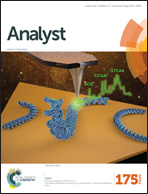A flowing atmospheric pressure afterglow as an ion source coupled to a differential mobility analyzer for volatile organic compound detection†
Abstract
Atmospheric pressure glow discharges have been widely used in the last decade as ion sources in ambient mass spectrometry analyses. Here, an in-house flowing atmospheric pressure afterglow (FAPA) has been developed as an alternative ion source for differential mobility analysis (DMA). The discharge source parameters (inter-electrode distance, current and helium flow rate) determining the atmospheric plasma characteristics have been optimized in terms of DMA spectral simplicity with the highest achievable sensitivity while keeping an adequate plasma stability and so the FAPA working conditions finally selected were: 35 mA, 1 L min−1 of He and an inter-electrode distance of 8 mm. Room temperature in the DMA proved to be adequate for the coupling and chemical analysis with the FAPA source. Positive and negative ions for different volatile organic compounds were tested and analysed by FAPA-DMA using a Faraday cup as a detector and proper operation in both modes was possible (without changes in FAPA operational parameters). The FAPA ionization source showed simpler ion mobility spectra with narrower peaks and a better, or similar, sensitivity than conventional UV-photoionization for DMA analysis in positive mode. Particularly, the negative mode proved to be a promising field of further research for the FAPA ion source coupled to ion mobility, clearly competitive with other more conventional plasmas such as corona discharge.



 Please wait while we load your content...
Please wait while we load your content...